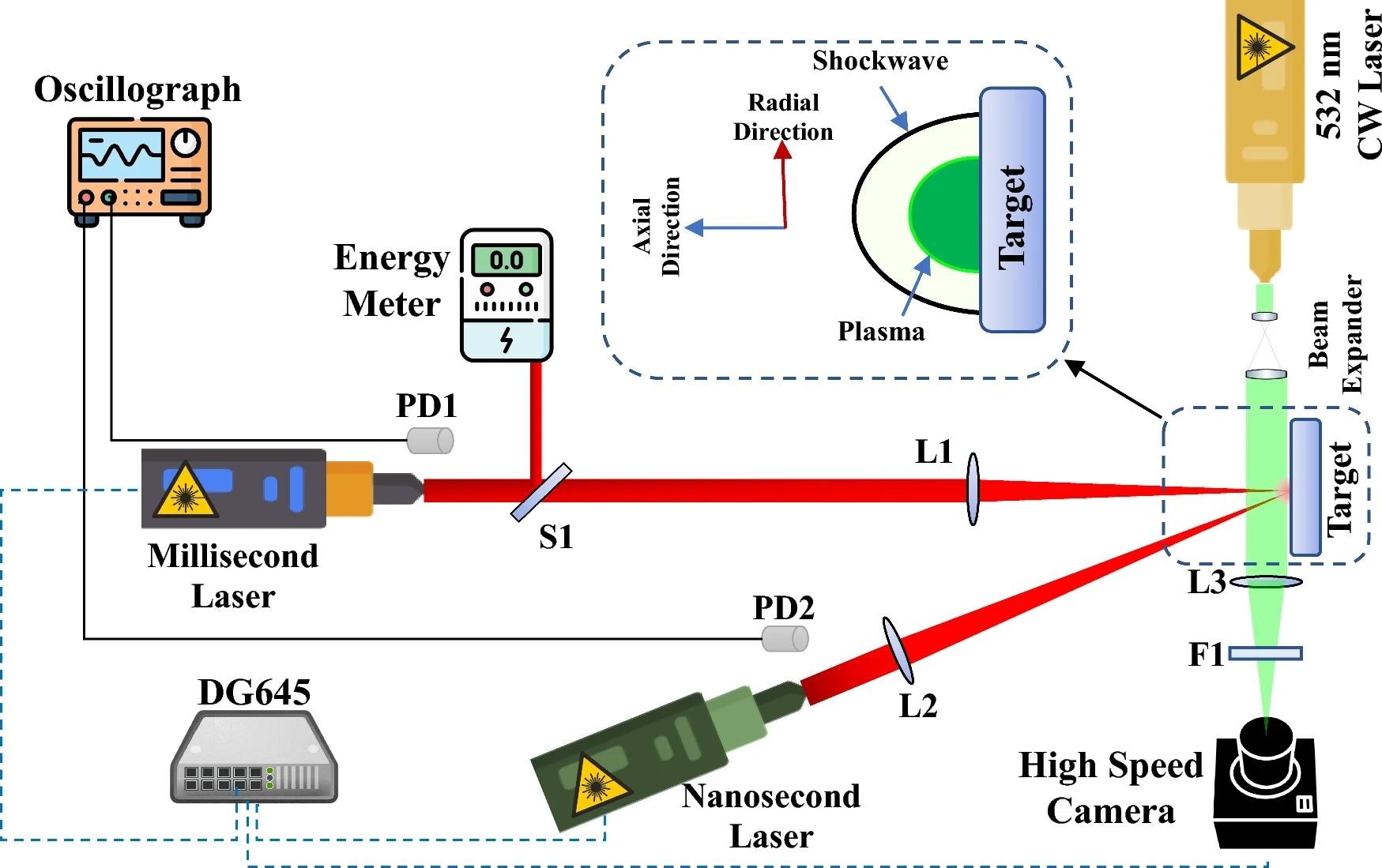In a paper published in the journal Scientific Reports, researchers explored the impact of laser-induced shock wave velocity on the efficiency of laser-based processes. Accurate estimation of shock wave velocity is crucial for optimizing experiments, developing laser systems, and achieving desired outcomes. Traditional methods using empirical equations and analytical models often need more accuracy.
 Experimental setup configuration for shock wave velocity. Image Credit: https://www.nature.com/articles/s41598-024-63616-5
Experimental setup configuration for shock wave velocity. Image Credit: https://www.nature.com/articles/s41598-024-63616-5
To address this, the researchers employed a combination of an artificial neural network (ANN) and a genetic algorithm (GA). This approach dynamically designs the neural network structure by adjusting its weights and configuration. The proposed method outperformed traditional techniques, achieving the lowest average errors and demonstrating high reliability in predicting shock wave velocity.
Background
Laser-induced shock wave dynamics have been extensively studied. One study linked shock-wave velocity to pressure using a nanosecond pulse laser. Another observed increased shock wave pressure in copper and aluminum with poly-methyl methacrylate (PMMA) as a confining layer.
Much research highlighted faster plasma expansion in water versus air, and another focused on plasma shock waves from picosecond pulse lasers on copper. Studies also explored shock wave modeling, cavitation bubbles, and laser velocimetry techniques, advancing the understanding of laser-material interactions and applications.
Accurate Shock Wave Prediction
The research consisted of two primary phases: laboratory experiments and simulations to measure and predict shock wave velocity accurately. In the laboratory phase, precise measurements of shock wave velocity were conducted under various experimental configurations using a combined pulse laser system. The setup involved nanosecond and millisecond lasers emitting at 1064 nm with pulse lengths of 10 ns and 1 ms, respectively. These experiments were crucial in generating the dataset used to train the ANN model in the subsequent phase.
Following the experimental phase, data collected on shock wave velocities were structured and utilized to train an ANN model. The dataset included measurements at regular time intervals and independent variables such as nanosecond laser energy density, millisecond laser energy density, and pulse delay. The goal was establishing a predictive model that effectively correlates these variables to predict shock wave velocity over time.
In the second phase, an ANN was selected due to its ability to handle complex, nonlinear relationships inherent in the shock wave velocity data. The multilayer perceptron (MLP) architecture was chosen over convolutional neural networks (CNNs) due to concerns regarding data structure and size limitations. The MLP's configuration was optimized using GA, which dynamically adjusted the network's architecture and weights to achieve the most accurate predictions.
The optimization began by defining an initial population of genetic algorithm chromosomes, assessing their fitness through prediction error, and progressively refining solutions through crossover and mutation. This approach aimed to overcome challenges such as overfitting and ensure robust performance in predicting shock wave velocity under various experimental conditions. Ultimately, the research demonstrated the effectiveness of integrating experimental precision with advanced computational techniques to accurately model and predict dynamic physical processes like shock wave propagation.
Predictive Analysis of Shock Waves
The research conducted a comparative analysis of different methods for predicting shock wave velocity and employing a rigorous 6-repetition cross-validation technique. The team evaluated three primary approaches: the proposed GA method for optimizing neural network topology and training, the Levenberg–Marquardt (trainLM) algorithm, and the scaled conjugate gradient backpropagation (TrainSCG) algorithm. The objective was to determine whether the GA-based optimization could yield superior predictive performance compared to conventional methods like trainLM and TrainSCG.
The evaluation focused on performance metrics such as root mean square error (RMSE), mean absolute error (MAE), and concordance correlation coefficient (CCC). Results consistently demonstrated that the proposed method outperformed alternative approaches regarding predictive accuracy.
Specifically, it consistently achieved lower RMSE and MAE values across various iterations and experimental settings. It highlights the robustness of the GA-driven approach in optimizing neural networks for accurate shock wave velocity prediction under different experimental conditions.
The research findings underscore the effectiveness of integrating GA-based optimization with neural networks. By leveraging GA to adjust neural network architecture and weights dynamically, the proposed method demonstrated enhanced predictive capabilities and reliability in modeling dynamic physical processes such as shock wave propagation. The study contributes valuable insights into advancing computational techniques for improving the accuracy of predictive models in experimental physics and related fields.
Conclusion
In summary, achieving precise estimations of shock wave speed was crucial across diverse fields such as material science, aeronautical engineering, and medicine. Neural networks increasingly supplemented traditional empirical methods due to their capability to discern complex patterns from data. The study significantly improved shock wave velocity prediction accuracy using neural networks.
The team employed dynamic network structures optimized through GA to adjust weights and determine topology, reducing MAE by at least 3.74 and RMSE by 4.38 compared to conventional methods such as ANN (trainLM) and ANN (TrainSCG). These findings underscored the potential of neural network-based methodologies to enhance the precision of forecasting laser-induced shock wave velocities, surpassing other comparative approaches.